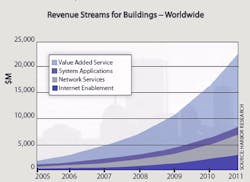The Pervasive Internet and the Progress of Intelligent Buildings
The term "intelligent building" has gained much recognition lately and, in many ways, is synonymous with the Pervasive Internet in a building (the convergence of pervasive or embedded computing with the Internet). Simply put, an intelligent building is a structure in which sensors, switches, and systems contained within the building's infrastructure are networked, communicating with each other and with a human operator through a control interface.
Building managers today are seeking cost-effective means for improved coordination of traditional systems while linking in other systems, such as parking, that have historically been standalone. The scale of larger commercial buildings increases ROI and justifies the costs of linking different systems and adding more devices.
What makes Internet-enabled applications attractive to building managers is easy installation, simple systems management, and a low price point. Regardless of building size, the overall goal of the building manager is maintaining an environment that is responsive to the needs of those that work, shop, or live there. The benefits of building-system interoperability are obvious. For example, linking life-safety systems to other building systems can improve response in an emergency. The fire system could alert the HVAC system to pressurize stairwells for occupant escape, elevators could be alerted to drop occupants off at the safest floor, and standby power could start up to activate emergency-exit lighting.
The fundamental difficulty in achieving building intelligence is communication. The first issue is compatibility (devices have not been built to speak the same language). The second issue is connectivity (for example, a fire alarm bought from the local drug store and located in an apartment bedroom runs on a battery and is only screwed into the ceiling - it is not connected to anything else).
Particularly within large commercial buildings, data exists and it is being collected - the issue is what happens next. How it is analyzed, what other types of data it is combined with, and how much human involvement is required all determine the value of data, not simply the fact that it exists.
Unfortunately, analysis is the area that remains the biggest obstacle in the development of the Pervasive Internet vision. Many companies are working toward this goal of information interoperability, but the truth is that we are still a long way away. Whether it is within an industrial plant, a consumer Web application, or a building, information is slowly becoming more transferable and pervasive. But, it is important to remember that it is the nature of the information itself - and of the software infrastructure surrounding it - that is driving this progress.
Brennan Igoe is senior analyst at San Francisco-based Harbor Research Inc. (http://harborresearch.com).

